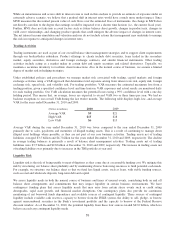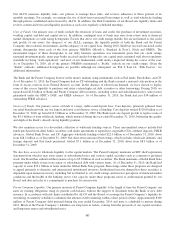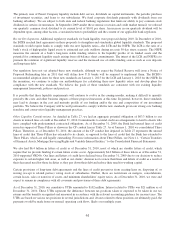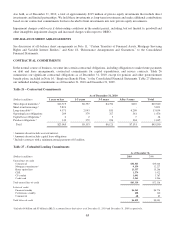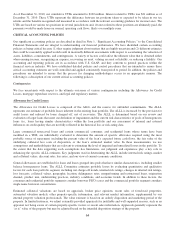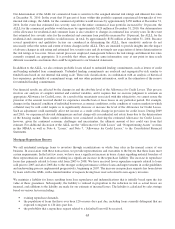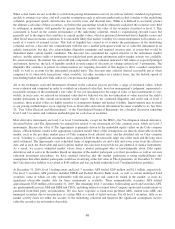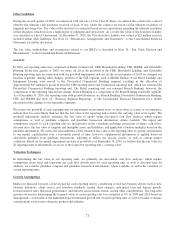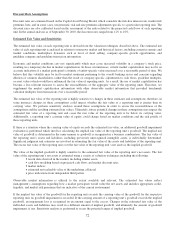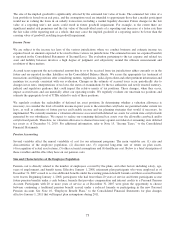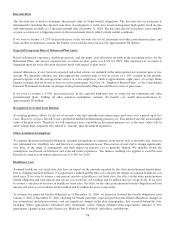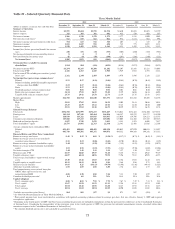SunTrust 2010 Annual Report Download - page 82
Download and view the complete annual report
Please find page 82 of the 2010 SunTrust annual report below. You can navigate through the pages in the report by either clicking on the pages listed below, or by using the keyword search tool below to find specific information within the annual report.
•the probability that a loan demanded for repurchase will be repurchased, and
•historical loss experience.
Some of the assumptions used in this process contain a level of uncertainty since these assumptions are largely derived from
historical experience that is limited and highly variable. As such, provision expense will vary as the estimates used to
measure the liability continue to be updated based on the level of repurchase requests, the latest experience gained on
repurchase requests and other relevant facts and circumstances. One of the most critical and judgmental assumptions is the
repurchase request rate because it requires us to make assessments regarding the actions that will be taken by third party
purchasers in the context of the limited and highly variable history we have experienced with their current volume of
requests.
Once we estimate the level of requests that we expect to receive by vintage, we apply factors for the probability that a loan
will be repurchased as well as the loss severity expected. Based on our experience during 2010, we estimate that our actual
repurchase rate relative to our demands will be approximately 50%. With regard to losses experienced on loan repurchases,
including make-whole settlements, our current experience has averaged approximately 50% of our demands. The experience
varies by vintage and will be affected by future housing price changes. We expect future repurchase related losses and
reserves will be largely driven by the volume of repurchase requests received from the GSEs, which have exhibited
considerable monthly volatility. To date, the majority of our repurchase requests have been associated with 2006 and 2007
vintages, which produce higher losses. However, we expect that normal seasoning patterns for origination vintages, over
time, will shift new repurchase requests to newer production vintages which have a lower risk profile. As that occurs, we
expect lower aggregate request volumes and lower loss frequencies and severities, as the newer vintages exhibit more
favorable characteristics, such as higher FICOs and lower original LTVs, as they were originated during or after periods that
experienced the most significant home price depreciation.
Assuming a simultaneous 10% adverse change in all three of our key assumptions, our reserve estimate would increase by
approximately $75 million. This sensitivity analysis is hypothetical in nature and intended to provide perspective on the
potential impact that changes in key assumptions would have upon our estimate. It is highly unlikely that future
developments would lead us to change key assumptions by the same relative percentage because they are likely to move
independently to some degree.
Various factors could potentially impact the accuracy of the assumptions underlying our mortgage repurchase reserve
estimate. As previously discussed, the level of repurchase and indemnification requests we receive is dependent upon the
actions of third parties and could differ significantly from the assumptions that we have made. Delinquency levels,
delinquency roll rates, and our loss severity assumptions are all highly dependent upon economic factors including changes
in real estate values and unemployment levels which are, by nature, difficult to predict. Loss severity assumptions could also
be negatively impacted by delays in the foreclosure process which is a heightened risk in some of the states where our loans
sold were originated. Approximately 15% of the population of loans sold between January 1, 2005 and December 31, 2010
were sold to non-agency investors, some in the form of securitizations. Due to the nature of these structures and the indirect
ownership interests, the potential exists that investors, over time, will become more successful in forcing additional
repurchase demands. While we have used the best information available in estimating the mortgage repurchase reserve
liability, these and other factors, along with the discovery of additional information in the future could result in changes in
our assumptions which could materially impact our results of operations.
Legal and Regulatory Matters
We are parties to numerous claims and lawsuits arising in the course of our normal business activities, some of which involve
claims for substantial amounts, and the outcomes of which are not within our complete control or may not be known for
prolonged periods of time. Management is required to assess the probability of loss and amount of such loss, if any, in
preparing our financial statements.
We evaluate the likelihood of a potential loss from legal or regulatory proceedings to which we are a party. We record a
liability for such claims when a loss is considered probable and the amount can be reasonably estimated. Significant
judgment may be required in the determination of both probability and whether an exposure is reasonably estimable. Our
estimates are subjective based on the status of the legal or regulatory proceedings, the merits of our defenses and consultation
with in-house and outside legal counsel. In many such proceedings, it is not possible to determine whether a liability has
66





